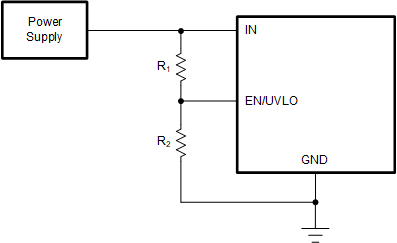ZHCSOF7B september 2022 – june 2023 TPS25990
PRODUCTION DATA
- 1
- 1 特性
- 2 应用
- 3 说明
- 4 Revision History
- 5 说明(续)
- 6 Pin Configuration and Functions
-
7 Specifications
- 7.1 Absolute Maximum Ratings
- 7.2 ESD Ratings
- 7.3 Recommended Operating Conditions
- 7.4 Thermal Information
- 7.5 Electrical Characteristics
- 7.6 Logic Interface DC Characteristics
- 7.7 Telemetry
- 7.8 PMBus Interface Timing Characteristics
- 7.9 External EEPROM Interface Timing Characteristics
- 7.10 Timing Requirements
- 7.11 Switching Characteristics
- 7.12 Typical Characteristics
-
8 Detailed Description
- 8.1 Overview
- 8.2 Functional Block Diagram
- 8.3
Feature Description
- 8.3.1 Undervoltage Protection
- 8.3.2 Insertion Delay
- 8.3.3 Overvoltage Protection
- 8.3.4 Inrush Current, Overcurrent, and Short-Circuit Protection
- 8.3.5 Single Point Failure Mitigation
- 8.3.6 Analog Load Current Monitor (IMON)
- 8.3.7 Overtemperature Protection
- 8.3.8 Analog Junction Temperature Monitor (TEMP)
- 8.3.9 FET Health Monitoring
- 8.3.10 General Purpose Digital Input/Output Pins
- 8.3.11 Stacking Multiple eFuses for Unlimited Scalability
- 8.3.12 General Purpose Comparators
- 8.3.13 Output Discharge
- 8.3.14
PMBus® Digital Interface
- 8.3.14.1 PMBus® Device Addressing
- 8.3.14.2 SMBus Protocol
- 8.3.14.3 SMBus™ Message Formats
- 8.3.14.4 Packet Error Checking
- 8.3.14.5 Group Commands
- 8.3.14.6 SMBus™ Alert Response Address (ARA)
- 8.3.14.7
PMBus® Commands
- 8.3.14.7.1
Detailed Descriptions of PMBus® Commands
- 8.3.14.7.1.1 OPERATION (01h, Read/Write Byte)
- 8.3.14.7.1.2 CLEAR_FAULTS (03h, Send Byte)
- 8.3.14.7.1.3 RESTORE_FACTORY_DEFAULTS (12h, Send Byte)
- 8.3.14.7.1.4 STORE_USER_ALL (15h, Send Byte)
- 8.3.14.7.1.5 RESTORE_USER_ALL (16h, Send Byte)
- 8.3.14.7.1.6 BB_ERASE (F5h, Send Byte)
- 8.3.14.7.1.7 FETCH_BB_EEPROM (F6h, Send Byte)
- 8.3.14.7.1.8 POWER_CYCLE (D9h, Send Byte)
- 8.3.14.7.1.9 MFR_WRITE_PROTECT (F8h, Read/Write Byte)
- 8.3.14.7.1.10 CAPABILITY (19h, Read Byte)
- 8.3.14.7.1.11 STATUS_BYTE (78h, Read Byte)
- 8.3.14.7.1.12 STATUS_WORD (79h, Read Word)
- 8.3.14.7.1.13 STATUS_OUT (7Ah, Read Byte)
- 8.3.14.7.1.14 STATUS_IOUT (7Bh, Read Byte)
- 8.3.14.7.1.15 STATUS_INPUT (7Ch, Read Byte)
- 8.3.14.7.1.16 STATUS_TEMP (7Dh, Read Byte)
- 8.3.14.7.1.17 STATUS_CML (7Eh, Read Byte)
- 8.3.14.7.1.18 STATUS_MFR_SPECIFIC (80h, Read Byte)
- 8.3.14.7.1.19 STATUS_MFR_SPECIFIC_2 (F3h, Read Word)
- 8.3.14.7.1.20 PMBUS_REVISION (98h, Read Byte)
- 8.3.14.7.1.21 MFR_ID (99h, Block Read)
- 8.3.14.7.1.22 MFR_MODEL (9Ah, Block Read)
- 8.3.14.7.1.23 MFR_REVISION (9Bh, Block Read)
- 8.3.14.7.1.24 READ_VIN (88h, Read Word)
- 8.3.14.7.1.25 READ_VOUT (8Bh, Read Word)
- 8.3.14.7.1.26 READ_IIN (89h, Read Word)
- 8.3.14.7.1.27 READ_TEMPERATURE_1 (8Dh, Read Word)
- 8.3.14.7.1.28 READ_VAUX (D0h, Read Word)
- 8.3.14.7.1.29 READ_PIN (97h, Read Word)
- 8.3.14.7.1.30 READ_EIN (86h, Block Read)
- 8.3.14.7.1.31 READ_VIN_AVG (DCh, Read Word)
- 8.3.14.7.1.32 READ_VIN_MIN (D1h, Read Word)
- 8.3.14.7.1.33 READ_VIN_PEAK (D2h, Read Word)
- 8.3.14.7.1.34 READ_VOUT_AVG (DDh, Read Word)
- 8.3.14.7.1.35 READ_VOUT_MIN (DAh, Read Word)
- 8.3.14.7.1.36 READ_IIN_AVG (DEh, Read Word)
- 8.3.14.7.1.37 READ_IIN_PEAK (D4h, Read Word)
- 8.3.14.7.1.38 READ_TEMP_AVG (D6h, Read Word)
- 8.3.14.7.1.39 READ_TEMP_PEAK (D7h, Read Word)
- 8.3.14.7.1.40 READ_PIN_AVG (DFh, Read Word)
- 8.3.14.7.1.41 READ_PIN_PEAK (D5h, Read Word)
- 8.3.14.7.1.42 READ_SAMPLE_BUF (D8h, Block Read)
- 8.3.14.7.1.43 READ_BB_RAM (FDh, Block Read)
- 8.3.14.7.1.44 READ_BB_EEPROM (F4h, Block Read)
- 8.3.14.7.1.45 BB_TIMER (FAh, Read Byte)
- 8.3.14.7.1.46 PMBUS_ADDR (FBh, Read/Write Byte)
- 8.3.14.7.1.47 VIN_UV_WARN (58h, Read/Write Word)
- 8.3.14.7.1.48 VIN_UV_FLT (59h, Read/Write Word)
- 8.3.14.7.1.49 VIN_OV_WARN (57h, Read/Write Word)
- 8.3.14.7.1.50 VIN_OV_FLT (55h, Read/Write Word)
- 8.3.14.7.1.51 VOUT_UV_WARN (43h, Read/Write Word)
- 8.3.14.7.1.52 VOUT_PGTH (5Fh, Read/Write Word)
- 8.3.14.7.1.53 OT_WARN (51h, Read/Write Word)
- 8.3.14.7.1.54 OT_FLT (4Fh, Read/Write Word)
- 8.3.14.7.1.55 PIN_OP_WARN (6Bh, Read/Write Word)
- 8.3.14.7.1.56 IIN_OC_WARN (5Dh, Read/Write Word)
- 8.3.14.7.1.57 VIREF (E0h, Read/Write Byte)
- 8.3.14.7.1.58 GPIO_CONFIG_12 (E1h, Read/Write Byte)
- 8.3.14.7.1.59 GPIO_CONFIG_34 (E2h, Read/Write Byte)
- 8.3.14.7.1.60 ALERT_MASK (DBh, Read/Write Word)
- 8.3.14.7.1.61 FAULT_MASK (E3h, Read/Write Word)
- 8.3.14.7.1.62 DEVICE_CONFIG (E4h, Read/Write Word)
- 8.3.14.7.1.63 BB_CONFIG (E5h, Read/Write Byte)
- 8.3.14.7.1.64 OC_TIMER (E6h, Read/Write Byte)
- 8.3.14.7.1.65 RETRY_CONFIG (E7h, Read/Write Byte)
- 8.3.14.7.1.66 ADC_CONFIG_1 (E8h, Read/Write Byte)
- 8.3.14.7.1.67 ADC_CONFIG_2 (E9h, Read/Write Byte)
- 8.3.14.7.1.68 PK_MIN_AVG (EAh, Read/Write Byte)
- 8.3.14.7.1.69 VCMPxREF (EBh, Read/Write Byte)
- 8.3.14.7.1.70 PSU_VOLTAGE (ECh, Read/Write Byte)
- 8.3.14.7.1.71 CABLE_DROP (EDh, Read/Write Byte)
- 8.3.14.7.1.72 GPDAC1 (F0h, Read/Write Byte)
- 8.3.14.7.1.73 GPDAC2 (F1h, Read/Write Byte)
- 8.3.14.7.1.74 INS_DLY (F9h, Read/Write Byte)
- 8.3.14.7.1
Detailed Descriptions of PMBus® Commands
- 8.3.14.8 Analog-to-digital Converter
- 8.3.14.9 Digital-to-analog Converters
- 8.3.14.10 DIRECT format Conversion
- 8.3.14.11 Blackbox Fault Recording
- 8.4 Device Functional Modes
- 9 Application and Implementation
- 10Device and Documentation Support
- 11Mechanical, Packaging, and Orderable Information
8.3.1 Undervoltage Protection
The TPS25990 implements undervoltage lockout on VDD and VIN in case the applied voltage becomes too low for the system or device to properly operate. The undervoltage lockout has a default internal threshold (VUVP) on VDD and programmable threshold (VUVLOIN) on VIN. Alternatively, the UVLO comparator on the EN/UVLO pin allows the undervoltage protection threshold to be externally adjusted to a user defined value. Figure 8-21 and Equation 1 show how a resistor divider can be used to set the UVLO set point for a given voltage supply.
 Figure 8-2 Adjustable Undervoltage Protection
Figure 8-2 Adjustable Undervoltage ProtectionThe VIN UVLO fault threshold can also be programmed using PMBus® writes to VIN_UV_FLT register.
The EN/UVLO pin implements a bi-level threshold and can be used to control the device from an external host.
- VEN > VUVLO(R): Device is fully ON.
- VSD(F) < VEN < VUVLO(F): The FET along with most of the controller circuitry is turned OFF, except for some critical bias and digital circuitry. Holding the EN/UVLO pin in this state for a duration greater than tQOD activates the Output Discharge function.
- VEN < VSD(F): All active circuitry inside the part is turned OFF and it retains no digital state memory. It also resets latched faults, status flags and configuration values written to the registers through PMBus® writes.